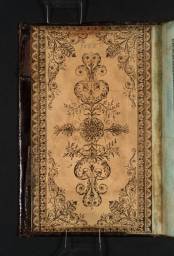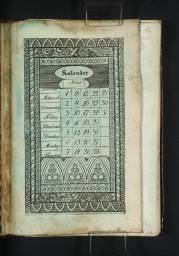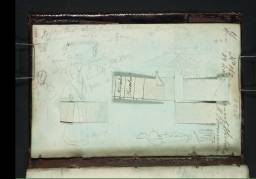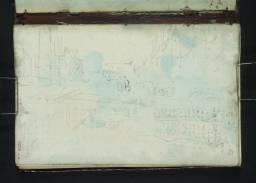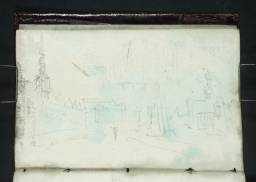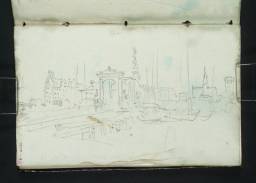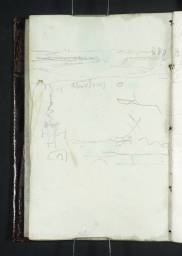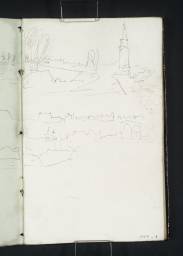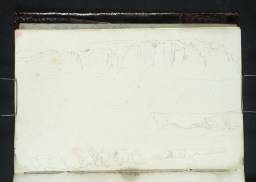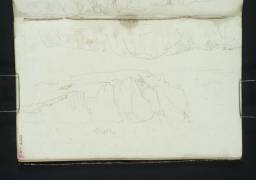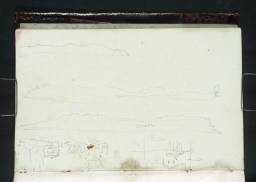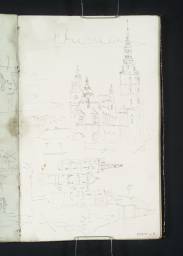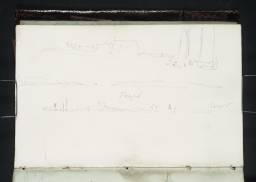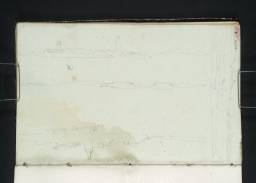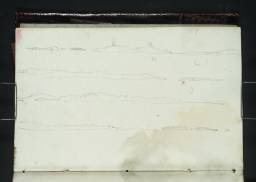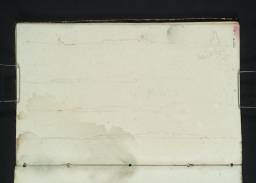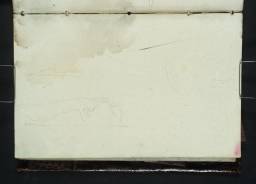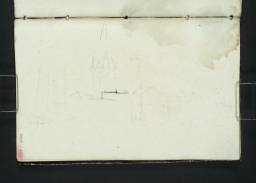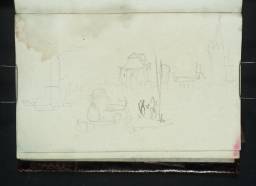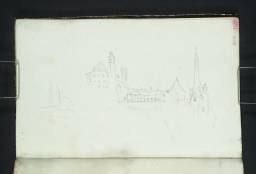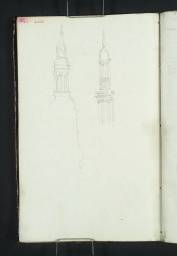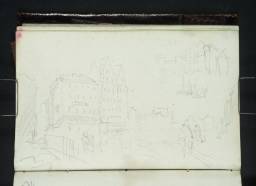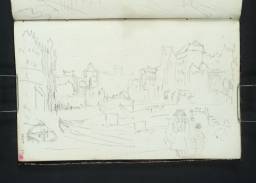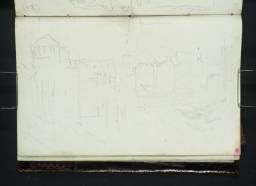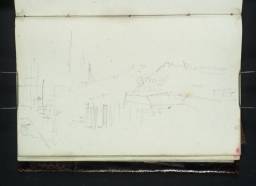CCCV 1–34
Pocket book bound in polished dark plum leather embossed with floret decorations and views of Bad Ems on the Lahn and Bingen on the Rhine
Two loops made of same leather for holding pencils attached to top and rear of inside front cover
Pages edge-painted in yellow
Front and rear endpapers decorated with printed acanthus and arabesque design and a neo-classical border
Printed perpetual calendar with moveable parts on front flyleaf (Tate D41036)
Inscribed in black ink ‘61/4’ at top left of Tate D30823; Turner Bequest CCCV 1
Signed by H.S. Trimmer in black ink and inscribed ‘No 362 | 33 leaves of pencil sketches’ at top centre of Tate D30823; Turner Bequest CCCV 1
Signed in pencil by Charles Locke Eastlake ‘C.L.E.’ and John Prescott Knight ‘JPK’ at top right of Tate D30823; Turner Bequest CCCV 1
Front endpaper inscribed in pencil ‘1080’ top centre
Blind-stamped with Turner Bequest monogram at top centre of outside front cover
Inscribed in pencil ‘CCCV’ at top centre of Tate D30823; Turner Bequest CCCV 1
Two loops made of same leather for holding pencils attached to top and rear of inside front cover
Pages edge-painted in yellow
Front and rear endpapers decorated with printed acanthus and arabesque design and a neo-classical border
Printed perpetual calendar with moveable parts on front flyleaf (Tate D41036)
Inscribed in black ink ‘61/4’ at top left of Tate D30823; Turner Bequest CCCV 1
Signed by H.S. Trimmer in black ink and inscribed ‘No 362 | 33 leaves of pencil sketches’ at top centre of Tate D30823; Turner Bequest CCCV 1
Signed in pencil by Charles Locke Eastlake ‘C.L.E.’ and John Prescott Knight ‘JPK’ at top right of Tate D30823; Turner Bequest CCCV 1
Front endpaper inscribed in pencil ‘1080’ top centre
Blind-stamped with Turner Bequest monogram at top centre of outside front cover
Inscribed in pencil ‘CCCV’ at top centre of Tate D30823; Turner Bequest CCCV 1
34 leaves of two or possibly three different papers:
Paper 1: corrected white laid writing made on a double-faced mould; chain lines: 28–9 mm apart, variable; laid lines: 10 per cm; watermarked: ‘Jordan’ with orb ornamented with laurel leaves
Paper 2: corrected white laid writing made on a double-faced mould; chain lines: 27 – 9 mm apart, variable; laid lines 9 – 10 per cm; watermarked: ‘Jordan’ with portrait head of Frederick William III in a patterned oval with ‘fr. wi. diii’ below
Paper 3: Highly glazed white wove hand-coated card, unknown maker
Approximate size of page 155 x 92 mm
Paper 1: corrected white laid writing made on a double-faced mould; chain lines: 28–9 mm apart, variable; laid lines: 10 per cm; watermarked: ‘Jordan’ with orb ornamented with laurel leaves
Paper 2: corrected white laid writing made on a double-faced mould; chain lines: 27 – 9 mm apart, variable; laid lines 9 – 10 per cm; watermarked: ‘Jordan’ with portrait head of Frederick William III in a patterned oval with ‘fr. wi. diii’ below
Paper 3: Highly glazed white wove hand-coated card, unknown maker
Approximate size of page 155 x 92 mm
Accepted by the nation as part of the Turner Bequest 1856
Exhibition history
References
Turner is thought to have arrived at the port of Hamburg in the first days of September1835. He probably purchased this sketchbook, the first of six used on the 1835 tour, at a stationer in the city. The book contains drawings of Hamburg’s harbours and churches, taken from vantage points on the Stintfang, the Binnenalster, Esplanade and Jungfernstieg. Sketches of Kiel on the Prussian Baltic follow those of Hamburg, along with drawings of the island of Moen, and finally Copenhagen, which Turner reached on 6 September. From the late fifteenth to eighteenth centuries Copenhagen was transformed into a major cultural centre. Under the direction of Christian IV and Frederick V in particular, landmarks like Christiansborg, Amalienborg and Rosenborg palaces were constructed, as well as important civic developments like the Christianshavn and Børsen. Turner recorded all these sites, and captured more in the second sketchbook of the tour: the Copenhagen to Dresden (Turner Bequest CCCVII).
According to the paper historian Peter Bower, the Hamburg and Copenhagen is the only sketchbook of the group to provide clues about the mills from which its papers were manufactured. At least two types were bound into the book: one bearing a watermark with an orb and laurel leaves and the other a portrait of the Prussian king Friedrich Wilhelm III (1770–1840). The maker of both papers went by the name of ‘Jordan’, and was based either at Hasserode Mill or Ilsenberg Mill at Magdeburg, Germany. The sketchbook is a pocketbook, bound in dark plum boards embossed with views of Bad Elms on the Lahn River and Bingen on the Rhine.
How to cite
Alice Rylance-Watson, ‘Hamburg and Copenhagen sketchbook 1835’, sketchbook, April 2015, in David Blayney Brown (ed.), J.M.W. Turner: Sketchbooks, Drawings and Watercolours, Tate Research Publication, August 2017, https://www

